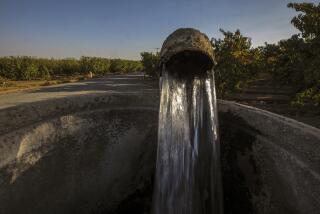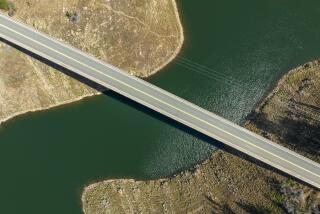New watering restrictions imposed amid California drought
- Share via
With California heading into another parched year, state officials Tuesday beefed up emergency drought regulations, directing urban agencies to limit the number of days residents can water their yards.
They also warned they will impose tougher restrictions in coming months if local agencies don’t ramp up conservation efforts.
“We are not seeing the level of stepping up and ringing the alarm bells that the situation warrants,” said Felicia Marcus, chairwoman of the State Water Resources Control Board.
Describing Tuesday’s action as “quite modest,” she said the board will discuss additional measures this spring. Those could include making emergency water restrictions permanent, requiring water districts to perform leak audits and setting targets for per capita water use.
The board initially ordered urban districts to rein in outdoor water use last summer, but enforcement has varied. Some cities only ban landscape irrigation during the heat of the day. “Some are really, really loose,” Marcus said.
Tuesday’s action steps up that order, requiring cities to limit watering days. The board didn’t specify a number, but if the water agencies don’t act within 45 days, the state will impose a two-day-a-week restriction. Cities with existing limits can maintain them, even if they permit watering on more than two days.
In Los Angeles, the new state rule “doesn’t change anything,” said Michelle Figueroa, spokeswoman for the city’s Department of Water and Power. The city has since 2009 restricted watering to three days a week.
Most other major Southern California cities have also capped watering days. But regulators don’t know how many agencies statewide have done that, making it difficult to gauge the overall effect of the new directive. Nor do they know how well water districts are enforcing their conservation measures -- something it hopes to change by requiring agencies to report enforcement and compliance actions.
The new drought rules also prohibit landscape irrigation during and for 48 hours after measurable rainfall, direct restaurants to serve water only on request and instruct hotels to offer customers the option of not having their linens and towels washed daily.
The state’s water situation is in some respects slightly better than it was a year ago. Precipitation in key watersheds in Northern California is 81% of normal for the date. Shasta Lake, California’s largest reservoir, is 58% full, compared with 45% a year ago. Lake Oroville is half full, compared with 45% at this time last year.
Customers of the State Water Project, which delivers supplies from Northern California to Southland cities, will get 20% of their contract requests, compared with only 5% in 2014.
But some smaller reservoirs in the southern Sierra Nevada have less in reserve than they did last spring. And most troubling to water managers is the statewide snowpack. At 12% of average, it has all but disappeared. At this time last year it was 28% of average. “That snowpack is just terrifying,” Marcus said Monday.
The mountain snowpack acts as a natural reservoir that in a normal year can hold much as a third of the state’s water supply, slowly releasing it throughout the spring as seasonal water demand rises. This year that release will be a trickle.
“Even though the [reservoir] levels are technically higher,” Marcus said, the state’s water situation “is worse” as the drought drags into its fourth year.
Central Valley farmers without senior water rights are for the second year in a row likely to get no supplies from the valley’s big federal irrigation project.
The Metropolitan Water District of Southern California, which imports supplies from Northern California and the Colorado River, is expected next month to consider allocating regional water deliveries, as it did during the 2007-09 drought. That will have a ripple effect throughout the Southland as local agencies react, probably by increasing water rates and adopting stronger conservation measures.
Twitter: @boxall
More to Read
Sign up for Essential California
The most important California stories and recommendations in your inbox every morning.
You may occasionally receive promotional content from the Los Angeles Times.














